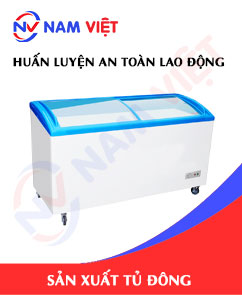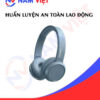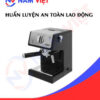Occupational Safety Training in Freezer Manufacturing
99,000 ₫
Note: The above price is calculated for one person, the price may fluctuate depending on the number of trainees participating in the course and depending on market movements. For more accurate pricing support, please refer to the quotation table or contact our consulting staff directly.
Occupational safety is an important issue in freezer manufacturing factories and needs to be addressed promptly to ensure the health and safety of workers, and to enhance the reputation of businesses. The Occupational safety training course is one of the effective solutions to raise awareness about accident prevention for workers participating in freezer manufacturing.
Table of Contents
Toggle1. Overview of Freezers
a. What is a Freezer?
A freezer is a type of refrigerator used to store food, meals, and beverages at very low temperatures to prevent spoilage. Freezers are commonly used in restaurants, supermarkets, grocery stores, or households for long-term food preservation or for freezing food.

b. Machinery used in freezer production
The machinery involved in the production and assembly of freezers includes:
- Sheet metal cutting machine: Used to cut and fabricate steel sheets into different components of the freezer.
- Steel bending machine: Used to bend steel into the shapes required for freezer components.
- Electronic welding machine: Used to weld the various components of the freezer together.
- Insulation machine: Used to wrap and insulate the freezer, maintaining stable internal temperatures.
- Painting machine: Used to paint the freezer after the production and assembly process is completed.
- Quality inspection machine: Used to check the quality of freezers before shipping.

c. Freezer manufacturing companies in Vietnam
Well-known freezer brands in Vietnam include:
- Sanaky: A brand of Sanaky Vietnam Co., Ltd., established in 1990 with headquarters in Ho Chi Minh City. Sanaky specializes in manufacturing and selling household electrical appliances, with freezers as one of its core products.
- Alaska: A freezer brand of Alaska Co., Ltd., established in 1997 in Ho Chi Minh City. Alaska is a leading brand in the field of household appliances, especially freezers with diverse models and modern features.
- Aqua: A freezer brand of Aqua Co., Ltd., established in 2004 in Hanoi. Aqua specializes in producing and supplying household appliances, with freezers being the most popular product. Aqua freezers are highly rated for quality, durability, and energy efficiency.
- Darling: A freezer brand of Darling Electronics Trading Co., Ltd., established in 2008 in Ho Chi Minh City. Darling is well-known for manufacturing and trading household electronic products, especially freezers with a wide range of models and designs.
- Sanyo: A brand of Sanyo Vietnam Co., Ltd., established in 1995 in Ho Chi Minh City. Sanyo specializes in producing and supplying household electronics and electrical appliances, with freezers highly valued for quality and modern features.
d. Specific jobs in a freezer manufacturing factory
Group 1
- CEO, Deputy CEO, Department Heads in the freezer manufacturing factory.
Group 2
- Safety officers: manage safety in the factory, design safety procedures, supervise and ensure employees follow safe working procedures.
Group 3
- Purchasing raw materials: Procure necessary materials for freezer production such as stainless steel, plastic, insulation, electrical systems, etc.
- Producing freezer components: Process, cut, bend, weld components like frames, doors, handles, cooling units, electrical systems, etc.
- Assembling freezers: Assemble components into a finished product and check product quality.
- Product testing: Conduct quality tests to ensure the products meet standards.
- Packing and shipping: Package products and deliver them to sales points, dealers, or warehouses.
- Maintenance and repair: Provide maintenance and repair services for customers to ensure the product functions properly.
Group 4
- Office, service, sales, and marketing tasks.
- Production management, quality management, human resources management, material management, financial accounting management.
- Product design: Research market needs and customer preferences to create new suitable freezer models.

2. Overview of occupational safety training for freezer production
In this article, we focus on issues concerning Group 3, as Group 3 is directly involved in production and faces the highest occupational safety risks. For information on other groups, see here.
a. What is Group 3 occupational safety training?
- Group 3 occupational safety training consists of sessions that provide workers with awareness on preventing workplace accidents.
- The training course helps workers identify and avoid hazards, reducing the risk of workplace accidents during work.
REGISTER FOR OCCUPATIONAL SAFETY TRAINING SERVICE
b. Training duration
Initial safety training
- Total training time is at least 24 hours, including testing time.
- 8 hours of theory on the system of policies and labor safety and hygiene laws
- 8 hours of theory on basic knowledge of labor safety and hygiene
- 4 hours of theory on specialized training content
- 2 hours of practical training on specialized content
- 2 hours of theoretical testing at the end of the course
The safety training center will schedule sessions depending on employee availability. Typically, there are 6 sessions over 3 days, provided the manufacturer arranges continuous learning time.
Periodic safety training
- Before the occupational safety card expires, workers who wish to renew must undergo periodic occupational safety training, with training time at least 50% of the initial training duration.
Explanation: The total periodic safety training duration is at least 12 hours, including testing. After completing the course and passing the test, workers will have their occupational safety cards renewed.
c. Training content
| No. | TRAINING CONTENT | TRAINING DURATION (HOURS) | |||
| Total | Including | ||||
| Theory | Practice | Test | |||
| I | System of policies and labor safety and hygiene laws | 8 | 8 | 0 | 0 |
| 1 | Overview of the system of legal documents on labor safety and hygiene. | 6 | 6 | ||
| 2 | System of safety and hygiene technical standards and regulations. | 1 | 1 | ||
| 3 | Specific regulations by state management agencies on labor safety and hygiene when constructing, expanding, or renovating production facilities, and for the use, storage, and inspection of machinery, equipment, materials, and substances with strict safety requirements. | 1 | 1 | ||
| II | Basic knowledge of labor safety and hygiene | 8 | 8 | 0 | 0 |
| 1 | Basic knowledge of hazardous and harmful factors in the workplace. | 4 | 4 | ||
| 2 | Methods to improve working conditions. | 1 | 1 | ||
| 3 | Safety culture in production and business. | 1 | 1 | ||
| 4 | Rights and obligations of employers and workers; policies on labor safety and hygiene; functions of safety officers. | 1 | 1 | ||
| 5 | Labor safety rules, signs, instructions, use of safety equipment and personal protective equipment; skills in first aid and occupational disease prevention. | 1 | 1 | ||
| III | Specialized training content | 6 | 4 | 2 | 0 |
| Comprehensive knowledge of machinery, equipment, substances that may cause hazards; analysis, risk management of labor safety, and safe work procedures with machines, equipment, and hazardous substances. | 6 | 4 | 2 | ||
| IV | End-of-course occupational safety assessment | 2 | 2 | 0 | 0 |
| Total | 24 | 22 | 2 | ||
See more training content for all 6 groups
d. Occupational safety card
After completing the occupational safety training and passing the test, workers will be issued an occupational safety card (commonly referred to as Group 3 safety certificate).
The Group 3 safety card includes personal information such as full name, date of birth, job position, and specific working environment, as well as training duration, red seal, and signature confirming course completion.
According to regulations on issuing safety cards outlined in Clause 2 of Article 24 of Decree 44/2016/ND-CP, there are two cases:
- If the employer and employee have a labor contract, the employer must sign, stamp, and validate the safety card for the trained Group 3 worker after the training course and passing the test.
- If the worker is freelance or seasonal and does not have a labor contract, the training unit must sign, stamp, and validate the safety card after the worker completes the training and passes the test.

3. Identifying Hazards Affecting Workers in Freezer Manufacturing
The process of manufacturing freezers can involve several hazards that may affect workers, including:
- Risk of collisions or injuries from falling heavy objects: During the movement and assembly of freezer components, employees may suffer accidents from falling heavy objects.
- Electrical hazards: Machinery used in freezer production consumes a large amount of electricity. Failure to comply with electrical safety regulations can cause fires, explosions, or electric shocks to employees.
- Chemical hazards: Solvents, chemicals, and dyes used in freezer manufacturing can pose health risks if not handled properly or if personal protective equipment is not used.
- Other occupational accidents: Incidents such as cuts, burns, or slips may occur while using tools and equipment during freezer production.
- Environmental pollution: Production processes, coating, and surface treatments in freezer manufacturing may release toxic gases, dust, and other pollutants, affecting workers’ health and the surrounding environment.
4. Common Occupational Accidents in Freezer Manufacturing
During freezer production, common occupational accidents include:
- Getting trapped: Workers may become trapped in equipment such as presses, cutting machines, drilling machines, milling machines, etc.
- Injuries from collisions: Workers can be injured by collisions with machinery or objects during production, or by falling heavy items.
- Burns or frostbite: Exposure to extremely high or low temperatures during production stages can cause burns, frostbite, or other thermal injuries.
- Scratches or cuts: Working with sharp tools may result in scratches or cuts on hands and arms.
- Chemical poisoning: Chemicals such as refrigerants, solvents, adhesives, etc., used in freezer production can cause chemical poisoning for workers.

5. Safety Measures for Participating in Freezer Manufacturing
Safety measures for participating in freezer production include:
- Ensure food safety and hygiene: Since freezers are used to store food, production must comply with food safety regulations, including using safe chemicals, maintaining machine hygiene, avoiding toxic substances, and following proper product packaging procedures.
- Wear personal protective equipment: Workers should wear helmets, masks, gloves, safety shoes, protective clothing, and safety goggles when working in dusty, noisy, or low-temperature environments.
- Safety skills training: Production staff should be trained in safety skills, including proper use of machinery, packaging, and handling common issues to ensure safety during production.
- Regularly inspect equipment: Staff should periodically check machinery, tools, and equipment to detect potential issues early and perform timely repairs.
- Follow production procedures: Staff must adhere to proper production processes, use machinery correctly, avoid overloading equipment, and carefully inspect products before packaging and shipment.
- Periodically conduct workplace environment monitoring in factories to collect and analyze harmful factors for workers, thereby reducing hazards and preventing occupational diseases.
6. Benefits of Occupational Safety Training for Freezer Manufacturing
An Toan Nam Viet provides businesses with the following benefits after completing occupational safety training courses according to Decree 44/2016/ND-CP on labor safety and hygiene:
- Workers can identify potential occupational hazards and take preventive measures to avoid accidents.
- Businesses can establish risk prevention measures in production, operation, and maintenance processes.
- Reduce costs associated with workplace safety incidents.
- Uninterrupted production increases labor productivity and product quality.
- Ensure compliance with labor safety laws, minimizing legal risks.
- Enhance credibility and professionalism, boosting the business’s brand value.
Nam Viet’s training courses help individuals protect themselves from external hazards to prevent injuries or, in severe cases, fatalities.
REGISTER FOR OCCUPATIONAL SAFETY TRAINING
7. Customer Feedback After Completing Occupational Safety Training for Freezer Manufacturing
An Toan Nam Viet has years of experience working with numerous businesses across Vietnam, particularly in southern provinces. This responsibility is highly valuable, which is why our occupational safety training has become increasingly professional. Our growth is driven by positive feedback and constructive suggestions from our clients. Below are testimonials from partners we have served.
Hoa Dat Construction and Trading Joint Stock Company
“Nam Viet’s service greatly simplified occupational safety and the completion of safety documentation for our work. The consulting team was enthusiastic and timely in answering our questions. Five stars for Nam Viet.”
See more customer interviews after using our services from An Toan Nam Viet
8. An Toan Nam Viet’s Occupational Safety Training Capabilities
An Toan Nam Viet is a leading and reputable occupational safety training center in Vietnam. Training sessions are continuously conducted at manufacturing workshops, factories, or construction sites across all 63 provinces in Vietnam.
REGISTER FOR OCCUPATIONAL SAFETY TRAINING
Occupational Safety Training License
- An Toan Nam Viet has been inspected and certified by the Labor Safety Department of the Ministry of Labor – Invalids and Social Affairs, certifying our qualification to conduct occupational safety and hygiene training. This further strengthens our occupational safety training capabilities.

Training Materials and Lectures
- Before being used in occupational safety training courses, materials are reviewed to ensure accurate knowledge and effective application.
- Instructors follow standardized teaching methods from An Toan Nam Viet, developed by experts in occupational safety and hygiene training to maximize knowledge retention for learners.
Facilities
- Controlling classroom factors enhances teaching efficiency and learner knowledge retention.
- Our training facilities feature spacious classrooms meeting standards for area, lighting, and training equipment.
9. Nationwide Reputable Occupational Safety Training Center
At An Toan Nam Viet, we prioritize professional dedication in occupational safety training. For us, imparting self-protection knowledge to workers contributes to building a safer workforce for the country.
To ensure effective training, we meticulously prepare every detail, from tools and teaching equipment to curriculum, materials, sound, and lighting.
Our instructors are experts with extensive experience in the field, with research on identifying hazards across various industries and methods to prevent them.
Lessons are practical, vivid, and easily understandable, allowing workers to learn comfortably and retain knowledge effectively. All teachings strictly follow Decree 44/2016/ND-CP.
Workers gain knowledge on hazard prevention and self-protection, applying it appropriately in real work scenarios.
Our training center prides itself on being a reputable, professional provider of occupational safety training with advantages including:
- Competitive training costs while maintaining high quality.
- Flexible training schedules aligned with company operations.
- Fast and legally compliant procedures for issuing training certificates.
- Instructors with long-term experience in the field.
- Classroom factors controlled to enhance teaching efficiency and learner comprehension.
- Lessons tailored to occupational safety in businesses.
- Dedicated, professional support for customers, promptly and accurately.

10. Additional References for Occupational Safety Training in Freezer Manufacturing
- Occupational safety materials for freezer manufacturing
- Occupational safety training material set
- Occupational safety training test set
- Occupational safety training syllabus for freezer manufacturing
- Occupational safety multiple-choice test for freezer manufacturing
1 review for Occupational Safety Training in Freezer Manufacturing
No comments yet















namchinh.haiphong341
Dịch vụ huấn luyện an toàn lao động rất tốt nhé, giảng viên dạy rất sinh động dễ hiểu!